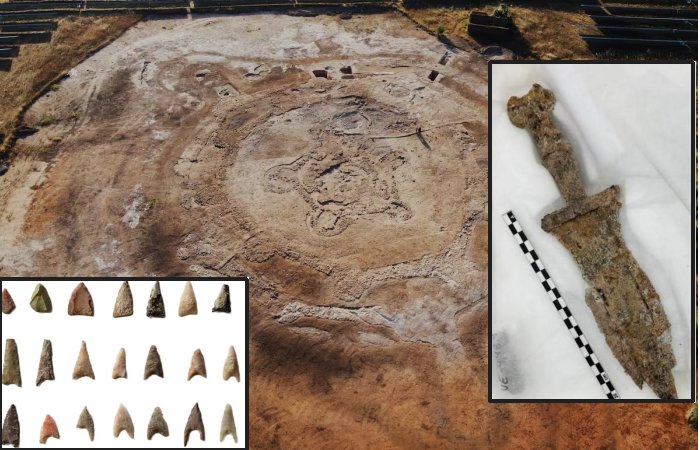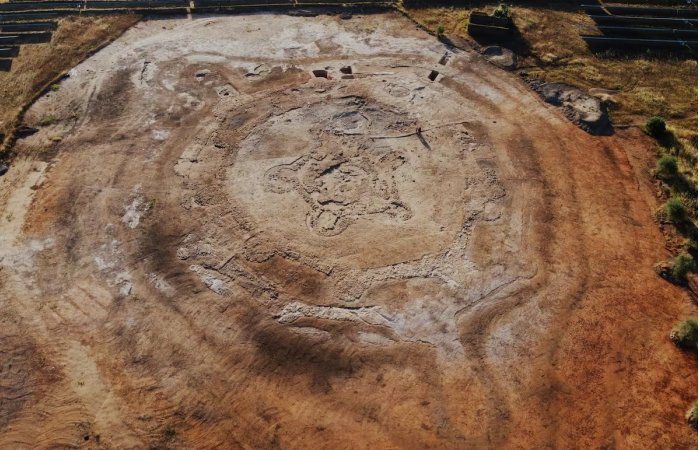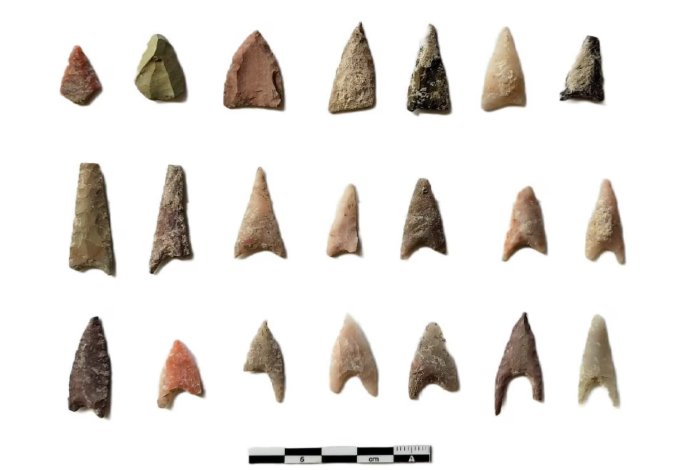Conny Waters – AncientPages.com – About 4, 900 years ago, humans built a fortress on a hill in present-day Almendralejo, Spain during the Copper Age. The stronghold featured three concentric walls, 25 towers, and three ditches up to four meters wide and two meters deep.
Aerial view of the Copper Age fortification located in Almendralejo. Image credit: Tera S.L.
Spanning 13, 000 square meters with stone and adobe walls, it had one narrow 70-centimeter entrance for defense. Inside, the tomb of a possible Roman legionary was discovered.
The Tera S. L. archaeological team uncovered this site in 2021 and continues to excavate it. Its characteristics closely resemble Los Millares in Almería, the reference model for Chalcolithic settlements in southeast Iberia.
Despite its formidable defenses, the fortress was ultimately destroyed, burned, and razed by adversaries before being abandoned 400 years after its construction. The identity of those who attacked and demolished this fortification, the methods they employed, and the specific purpose it served in terms of protection remain questions that have yet to be answered.
Archaeologists have found artifacts like arrowheads, idols, axes, grinding stones, plates, bowls, and loom components at the site. These findings offer valuable insight into past activities inside the fortification.
The archaeological team states that the pentagonal fortress, the first on a hill 314 meters above sea level, provided a commanding view. Its original structure had an adobe wall 1. 3 to 1. 5 meters thick, five bastions, and an entrance “shaped like crab claws.”
A ‘pugio’ found in the Cortijo Lobato archaeological site. Image cREDit: Tera S.L.
Two more concentric walls were added, reinforced by three ditches. This created a formidable defense with 25 bastions strategically designed to maximize firing angles and provide protection from multiple points.
The three ditches were physical barriers and discouraged attackers and forcing invaders to navigate extra obstacles before reaching the walls, explains Pérez. The defensive complex was uncovered during surveys for a photovoltaic solar park by Acciona Energía on the estate of the Marquis of the Encomienda. Near Cortijo Lobato, researchers found Chalcolithic-era materials concentrated in an olive grove. This discovery led to protocols for site protection, investigation, and impact prevention financed by the company. The fortification included cabins and a water reservoir to sustain residents during sieges.
“The complex system of stone and earth walls and ditches shows careful planning, requiring coordination among many people. This suggests a hierarchy capable of overseeing such a project. The sophisticated design and need for a large workforce indicate a well-organized community,” explains César M. Pérez, director of the excavations.
Copper Age arrowheads found in Cortijo Lobato. Image credit: Tera S.L.
Archaeologists found evidence that Cortijo Lobato suffered an intentional fire. Wooden doors embedded in adobe walls burned, far from other flammable materials, suggesting the fire was deliberate, possibly during an assault breaching defenses and destroying the settlement.
Numerous arrowheads were found among the ruins.
Cortijo Lobato was abandoned around 2450 BC, based on carbon-14 dating of animal remains in the ashes. Human presence reappeared during the Late Roman Empire (2nd–3rd centuries AD), after a 2, 700-year gap. Archaeologists found an unusual grave near the second defensive ditch from this later period.
The shallow grave belonged to a man, aged 25 to 35, face down with a pugio (dagger) on his back.
This suggests the individual may have had a military role, as the pugio was the standard dagger for Roman legionaries. The burial was likely hasty since “the pit was barely deep enough to contain the body,” according to the researcher.
The skeleton was nearly complete except for the feet, which seemed cut off. The dagger was remarkably well-preserved, fully intact and still in its sheath.
The Roman pugio, dating to the late 1st century BC, was inspired by earlier daggers from pre-Roman Hispania. Celtiberians used similar weapons since the late 4th century BC, while other groups favored a curved-edged dagger from the late 3rd century BC. Roman legionaries encountered these during battles in the 2nd century BC and prized them as war trophies. The pugio was eventually modified and adopted as standard equipment for legionaries across the empire.
Initially, archaeologists debated if the skeletal remains were those of a soldier or a civilian with a dagger. The deliberate placement of the pugio suggests he was an army member given a dishonorable burial, hinting at an untold story. If confirmed as a soldier, he likely belonged to Legio VII Gemina, the only Roman legion in Hispania then, established in 74 AD and based in Legio (modern León).
Unlike other legions focused on direct military campaigns, Legio VII Gemina mainly performed escort duties, road surveillance, and provincial security.
Restoration specialist Maicu Ortega from Madrid Complutense University treated the recovered pugio for analysis, consolidation, and partial stabilization. Researchers are also trying to extract DNA from one of the individual’s teeth.
The cause of death, face-down burial with severed feet, and pugio placement on the back remain “a real mystery” to archaeologists.
Written by Conny Waters – AncientPages.com Staff Writer











